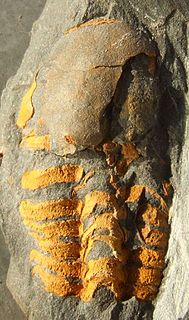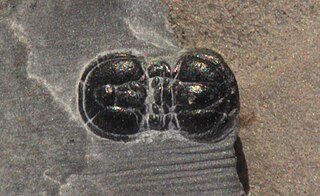Related Research Articles

John William Salter was an English naturalist, geologist, and palaeontologist.

Rock Point Provincial Park is a park located on the north shore of Lake Erie near the mouth of the Grand River in the Carolinian zone of southwestern Ontario. It occupies an area of 1.87 square kilometres (0.72 sq mi).

Agraulos Hawle & Corda 1847, is a genus of trilobites that lived during the Middle Cambrian in North America and Europe, particularly the Czech Republic.

Henry Hicks (1837–1899) was a Welsh physician and geologist during the 19th century.

Peronopsis is a genus of trilobite restricted to the Middle Cambrian. Its remains have been found in Asia, Australia, Europe, and North America.

The Wheeler Shale is a Cambrian (c. 507 Ma) fossil locality world-famous for prolific agnostid and Elrathia kingii trilobite remains and represents a Konzentrat-Lagerstätten. Varied soft bodied organisms are locally preserved, a fauna and preservation style normally associated with the more famous Burgess Shale. As such, the Wheeler Shale also represents a Konservat-Lagerstätten.
The European Land Mammal Mega Zones are zones in rock layers that have a specific assemblage of fossils (biozones) based on occurrences of fossil assemblages of European land mammals. These biozones cover most of the Cenezoic, with particular focus having been paid to the Neogene and Paleogene systems, the Quaternary has several competing systems. In cases when fossils of mammals are abundant, stratigraphers and paleontologists can use these biozones as a more practical regional alternative to the stages of the official ICS geologic timescale. European Land Mammal Mega Zones are often also confusingly referred to as ages, stages, or intervals.
The Dresbachian is a Maentwrogian regional stage of North America, lasting from 501 to 497 million years ago. It is part of the Upper Cambrian and is defined by four trilobite zones. It overlaps with the ICS-stages Guzhangian, Paibian and the lowest Jiangshanian.

Pagetia is a small genus of trilobite, assigned to the family Eodiscidae and which had global distribution during the Middle Cambrian. The genus contains 55 currently recognized species, each with limited spatial and temporal ranges.
Trilobites are used as index fossils to subdivide the Cambrian period. Assemblages of trilobites define trilobite zones. The Olenellus-zone has traditionally marked the top of the Lower Cambrian, and is followed by the Eokochaspis zone.

Ptychagnostus is a member of the agnostida that lived during the Cambrian period. Ptychagnostidae generally do not exceed one centimetre in length. Their remains are rarely found in empty tubes of the polychaete worm Selkirkia. The genus probably ranged throughout the water column. It has two glabellar lobes, and three pygidial lobes,.
The Marjum Formation is a Cambrian geological formation that overlies the Wheeler Shale in the House Range, Utah. It is known for its occasional preservation of soft-bodied tissue, and is slightly younger than the Burgess Shale, falling in the Ptychagnostus praecurrens trilobite zone.
Burlingia is a rare and diminutive genus of trilobite, that lived during the early to middle Middle Cambrian. Species assigned to Burlingia have been found in Norway, Sweden, Northern Siberia, and South-eastern China.

Ptychagnostus atavus is a species of agnostid trilobite. It was originally described by Swedish paleontologist Sven Axel Tullberg as Agnostus atavus in 1880. It is used in biostratigraphy as an index fossil. Its first appearance at the GSSP section in the Wheeler Shale of Utah is defined as the beginning of the Drumian Age of the Miaolingian.

Ptychagnostidae is a family of agnostid trilobites from the 5th Stage to the Paibian Age of the Cambrian. The family includes several important index fossils.

Glyptagnostus reticulatus is a species of agnostid trilobite belonging to the genus Glyptagnostus. It existed during the Paibian Age of the Cambrian. It has a cosmopolitan distribution and is an important index fossil in biostratigraphy. It was characterized by an unusual net-like pattern of furrows on both the cephalon and the pygidium.

The Peronopsidae comprise the earliest family of the Agnostina suborder. Species of this family occurred on all paleocontinents. The earliest representatives of this family first occur just before the start of the Middle Cambrian, and the last disappeared just after the start of the Upper Cambrian.

Itagnostus is a genus of trilobite restricted to the Middle Cambrian. Its remains have been found in Asia, Australia, Europe, and North America.
Schmalenseeia is genus of trilobites of uncertain affinity, that lived during the middle Middle to earliest Upper Cambrian. Species assigned to Schmalenseeia have been found in Norway, Sweden, Northern Siberia, Eastern China, Australia (Tasmania), India (Himalayas) and the United Kingdom.

The Namaqua Fossil Forest Marine Protected Area is an offshore conservation region in the territorial waters/exclusive economic zone of South Africa
References
- 1 2 Sepkoski, Jack (2002). "A compendium of fossil marine animal genera (Trilobita entry)". Bulletins of American Paleontology. 364: 560. Retrieved 2008-01-12.
| This Ptychopariida-related article is a stub. You can help Wikipedia by expanding it. |
| This article related to a Cambrian animal is a stub. You can help Wikipedia by expanding it. |